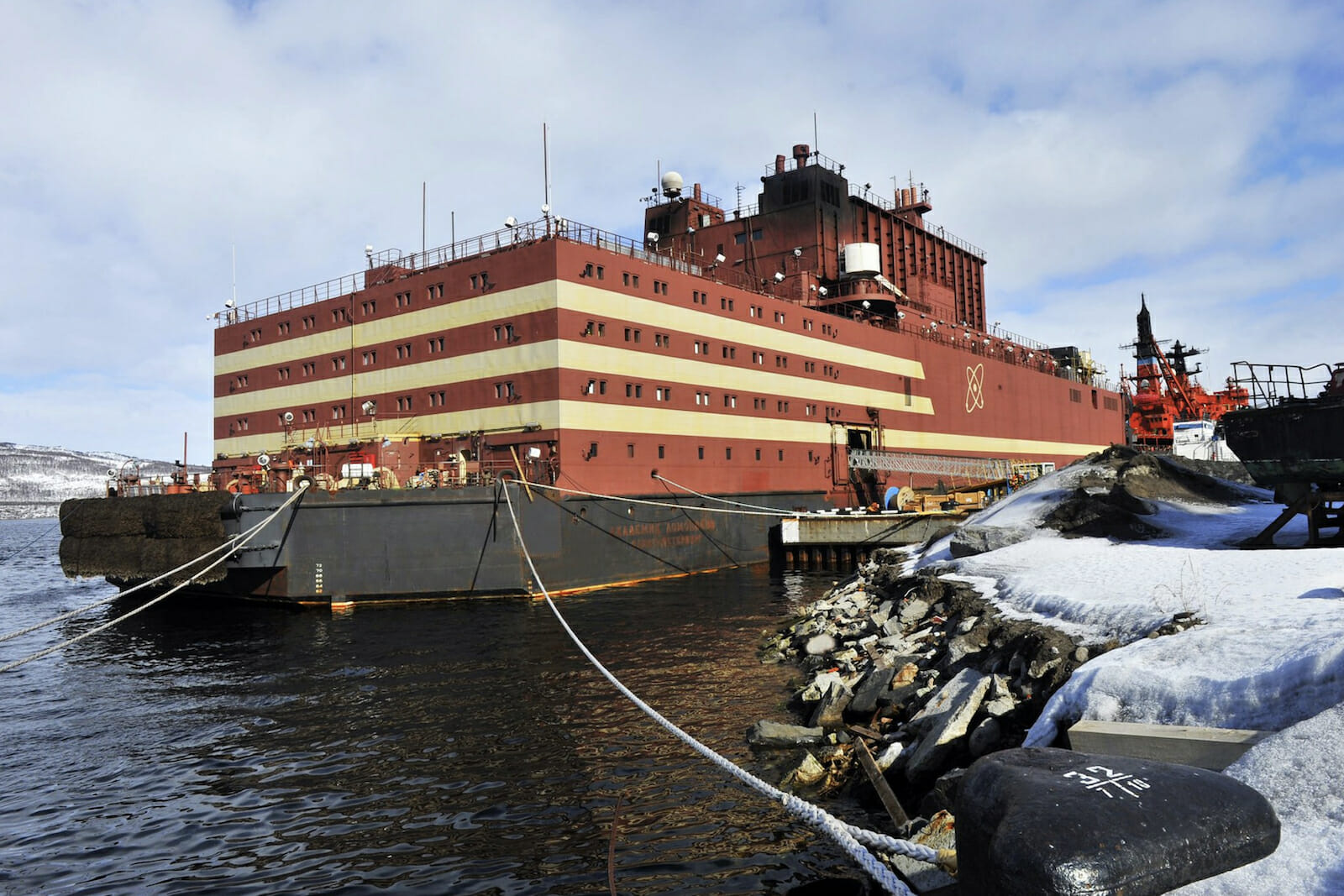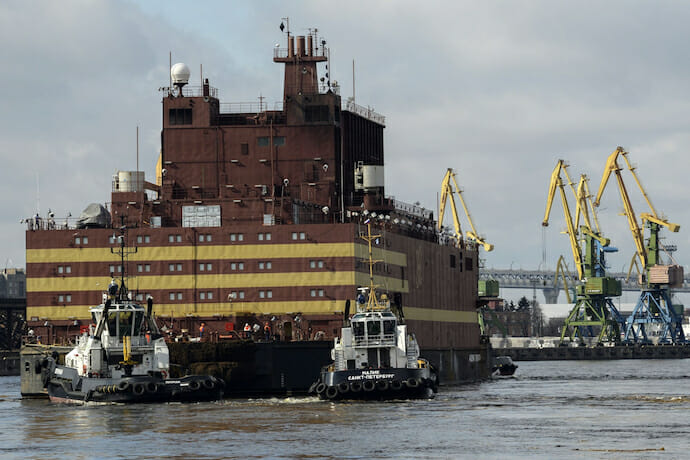
Russia’s Floating Nuclear Power Station Expected to Change the Arctic
Imagine two football pitches joined together. Now picture them floating out to sea. And then you have the Akademik Lomonosov. The Akademik Lomonosov is a massive floating nuclear power plant (FNPP), run by Russia’s Rosatom, which is set for launch later this week. More than that, though, it represents a significant milestone for nuclear power development and also confirms Russia’s leading position in it.
Its marathon 5,000 km journey along the Arctic coast to Chukotka, the most remote and extreme in Russia’s weather regions, begins this Friday when the twin-reactor plant is towed from Murmansk to the tiny port of Pevek on the Russian Far East coastline of the Arctic Ocean. Once there it will rest offshore and will begin pumping out electricity as the world’s northernmost nuclear power station.
Russia’s first-ever floating nuclear power plant has already made headlines in the West and has not escaped criticism from environmental advocates such as Greenpeace who argue it might have been cheaper to invest the money in the development of renewable energy in the region rather than sustaining a floating power plant.
But comparing the FNNP to Chernobyl, as Greenpeace has, is a “scare tactic” says Dale Klein, the former head of the Nuclear Regulatory Commission under President George W. Bush. “It’s just to make people think about an accident of some kind. It has no basis in science and it’s really just meant to scare people when you use those kinds of statements,” he said.
Experts say that a wind power alternative has its drawbacks. “Wind power generators are effective for powering particular households but won’t be able to supply electricity to the whole region on an industrial scale,” claims Petr Pushkaryov, a chief analyst at TeleTrade.
“The main advantage of this plant is in its mobility and ability to work for 15 years without rest. Plus, there will be no radioactive waste on land after its exploitation,” said Gaidar Gasanov, an expert at the International Financial Centre.
The 472 foot long platform, equipped with two KLT-40 nuclear reactors, can produce up to 70 megawatts (MW) of electricity and 50 Gcal/h of thermal power. That’s enough to supply energy to 100,000 inhabitants – equal to around seven percent of what a large commercial reactor in the U.S. typically produces.
Its keenly-awaited launch this week comes amid an international scramble for new territory, the likes of which the world hasn’t witnessed since the 18th century. The Akademik Lomonosov is, in fact, part of Russia’s broader strategy of taking advantage of the rapid loss of sea ice in the Arctic. It wants to position itself as the ‘gatekeeper’ for the expected explosion of shipping routes through the rapidly expanding waterway on its northern border with the Arctic Ocean.

With a minimum 40-year life cycle, the Akademik Lomonosov – named after 18th-century Russian scientist Mikhail Lomonosov – was commissioned by Rosenergoatom (a division of Rosatom) and designed by Russian atomic scientists and naval architects. It features cutting edge safety and security systems and, if successful, will represent another milestone in Moscow’s efforts to tame the melting Northern Sea Route, which, largely as a result of climate change, could become a direct trade route between Europe and Asia.
Russia, which already has extensive experience in building nuclear icebreakers and nuclear submarines, has been pursuing its ‘experiment’ in floating nuclear power, confounding critics who said the plant was an expensive publicity stunt that was doomed to fail.
Arctic sea ice levels have reduced by 40 percent since the late 1970s, opening up the northern sea route as a transport artery, and the vessel is seen as a ‘cure-all’ for the energy woes of the world’s more remote regions.
The media have been granted numerous tours of the vessel and even groups like The Bellona Foundation, which covers environmental issues in the Arctic region and has voiced reservations, has welcomed what it calls “the spirit of openness” during the plant’s path to deployment and Rosatom’s efforts to be transparent about its endeavours.
The whole idea of a floating nuclear plant has triggered not only curiosity but competition. Two state-backed companies in China are said to be pursuing plans for at least 20 floating nuclear plants while American scientists have drawn up blueprints of their own. However, it must be said that this isn’t the first floating nuclear power plant. During the 1960s, the United States maintained a floating nuclear plant in the Panama Canal.
It’s estimated that two-thirds of Russia’s oil and gas reserves are in its Arctic exclusive economic zone and the region accounts for 20 percent of the nation’s GDP. Use of the Arctic would cut the shipping time from Europe to China by 40 percent. Russia’s two-pronged Arctic strategy is thus to reap the benefits of resource extraction and increased shipping.
A World Nuclear Association report describes the “enormous potential” of such nuclear reactors and Rosatom echoes these claims, citing the added benefit of bringing “economic development to remote and hard-to-reach territories.”
Rosatom says that a floating nuclear reactor is perfect for the Russian Arctic and that the future of Chukotka region’s inhabitants hinges on the project. Once up and running, it will replace an aging coal-fired power plant, saving about 500,000 tons of CO2 emissions per year compared to fossil fuels alternatives.
The company argues that the power unit will “contribute to the sustainable development of the Arctic region and to the fight against climate change by offering zero-carbon electricity generation and replacing heavy polluting fossil-fuel power sources.”
A source at the European Commission in Brussels says that considering the growing demand for electricity globally and the need to be able to supply it where and when it is needed, the future for FNPPs “looks bright” due to their growing popularity as a “mobile, safe and self-contained” source of low-carbon energy. “In addition to power generation, FNPPs can also contribute to solving other important issues that remain high on many countries’ agendas, such as freshwater deficiency, a problem especially pressing in arid desert regions of the Middle East,” said the EU source.
The aim, he said, is to enable “reliable, safe and affordable” energy and ensure sustainable development of the key industries in the destination region.
FNPPs produces no CO2 or other polluting emissions and upon decommissioning, Akademik Lomonosov will be towed to a special deconstruction and recycling facility. No spent nuclear fuel or radioactive waste is planned to be left in the Arctic and spent fuel will be taken to special storage facilities on mainland Russia.
Optimized floating power unit (OFPU) developed by Rosatom and based on Akademik Lomonosov technology, have the potential to work particularly well in regions with extended coastlines, power supply shortages and limited access to electrical grids. The plant can be delivered to any point along a coast and connected to existing electrical grids. These points, it is argued, make OFPU a “unique proposal” on the world’s nuclear market and some countries from the Middle East, Asia, and Latin America have already entered negotiations about buying such a unit.
Rosatom is already working on next-generation FPUs, or OFPUs, which will be equipped with two RITM-200M reactors (each with a capacity of 50 MWe).
Oscar Voss, of the University of Aberdeen, says all this does not exist in isolation, pointing out that the Russian government is intent on developing its Arctic zone, a region whose thawing ice has presented the country (and others) with exciting new opportunities.
Clearly, the Lomonosov is a significant part of that effort.

